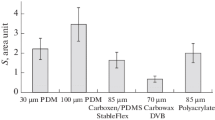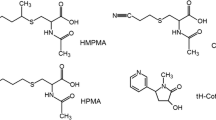Abstract
The amount of volatile dimethylselenide (DMSe) in breath has been monitored after ingestion of sub-toxic amounts of selenium (300 μg 77Se, as selenite) by a healthy male volunteer. The breath samples were collected in Tedlar bags every hour in the first 12 h and then at longer intervals for the next 10 days. The samples were subjected to speciation analysis for volatile selenium compounds by use of cryotrapping–cryofocussing–GC–ICP–MS. Simultaneously, all urine was collected and subjected to total selenium determination by use of ICP–MS. By monitoring m/z 82 and 77, background or dietary selenium and selenium from the administered selenite were simultaneously determined in the urine and in the breath—dietary selenium only was measured by monitoring m/z 82 whereas the amount of spiked 77Se (99.1% [enriched spike]) and naturally occurring selenium (7.6% [natural abundance]) were measured by monitoring m/z 77. Quantification of DMSe was performed by using DMSe gas samples prepared in Tedlar bags (linear range 10–300 pg, R 2=0.996, detection limit of Se as DMSe was 10 pg Se, or 0.02 ng L−1, when 0.5 L gas was collected). Dimethylselenide was the only selenium species detected in breath samples before and after the ingestion of 77Se-enriched selenite. Additional DM77Se was identified as early as 15 min after ingestion of the isotopically-labelled selenite. Although the maximum concentration of 77Se in DMSe was recorded 90 min after ingestion, the natural isotope ratio for selenium in DMSe (77/82) was not reached after 20 days. The concentration of DMSe correlated with the total Se concentration in the urine during the experiment (R 2=0.80). Furthermore, the sub-toxic dose of 300 μg selenium led to a significant increase of DMSe and renal excretion of background selenium, confirming that selenium ingested as selenite is homeostatically controlled by excretion. The maximum concentration of DMSe resulting from the spiked selenite was 1.4 ng Se L−1 whereas the dietary background level was less than 0.4 ng Se L−1. Overall excretion as DMSe was calculated to be 11.2% from the ingested selenite within the first 10 days whereas urinary excretion accounts for nearly 18.5%.








Similar content being viewed by others
Reference
Behne D, Kyriakopoulos A (2001) Annu Rev Nutr 21:453–473
Nakamuro K, Jyotatsu Y, Okuno T, Hasegawa T, Sayato Y (1996) Jap J Toxicol Environ Health 42:340–347
Vadhanavikit S, Ip C, Ganther HE (1993) Xenobiotica 23:731–745
Young V, Garza C (eds) (2000) Dietary reference intakes for vitamin C, vitamin E, selenium, and carotenoids. Academic, New York, pp 384–386
Barceloux DG (1999) J Toxicol Clin Toxicol 37:145–172
Miekisch W, Schubert JK, Noeldge-Schomburg GFE (2004) Clin Chim Acta 347:25–39
Jiang S, Robberecht H, Adams F, Vandenberghe D (1983) Toxicol Environ Chem 6:191–201
Feldmann J, Riechmann T, Hirner AV (1996) Fresenius J Anal Chem 354:620–623
Knutson MD, Viteri FE (1996) Anal Biochem 242:129–135
Haas K, Feldmann J (2000) Anal Chem 72:4205–4211
Uden PC, Boakye HT, Kahakachchi C, Tyson JF (2004) J Chromatogr A 1050:85–93
Haas K, Feldmann J, Wennrich R, Stark HJ (2001) Fresenius J Anal Chem 370:587–596
Wehmeier S, Ellam RM, Feldmann J (2003) J Anal At Spectrom 18:1001–1007
Wehmeier S, Raab A, Feldmann J (2004) Appl Organomet Chem 18:631–639
Navarro-Alarcon M, de la Serrana HLG, Perez-Valero V, Lopez-Martinez (1999) Sci Total Environ 228:79–85
Molnar J, MacPherson A, Barclay I, Molnar P (1995) Int J Food Sci Nutr 46:343–352
Barclay NMI, MacPherson A (1992) Br J Nutr 68:261–270
Ganther HE (1986) J Am Coll Toxicol 5:1–5
Foster SJ, Kraus RJ, Ganther HE (1986) Arch Biochem Biophys 247:12–19
Kobayashi Y, Orga Y, Ishiwata K, Takayama H, Aimi N, Suzuki KT (2002) Proc Natl Acad Sci U S A 99:15932
Whanger PD (1998) J Trace Elem Exp Med 11:227–240
Reid ME, Stratton MS, Lillico AJ, Fakih M, Natarajan R, Clark LC (2004) J Trace Elem Med Biol 18:69–74
Acknowledgements
The authors thank Prof. E. Larsen (Copenhagen) for his initial discussion and BayCEER and Johannes Gutenberg University (Mainz) for financial support of DK.
Author information
Authors and Affiliations
Corresponding author
Rights and permissions
About this article
Cite this article
Kremer, D., Ilgen, G. & Feldmann, J. GC–ICP–MS determination of dimethylselenide in human breath after ingestion of 77Se-enriched selenite: monitoring of in-vivo methylation of selenium. Anal Bioanal Chem 383, 509–515 (2005). https://doi.org/10.1007/s00216-005-0001-1
Received:
Revised:
Accepted:
Published:
Issue Date:
DOI: https://doi.org/10.1007/s00216-005-0001-1




